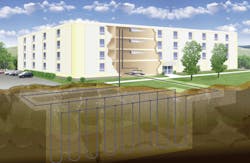Geothermal Applications Ideal for K-12 Environments
By ALAN YOUKER
Daikin Applied
Minneapolis MN
K-12 schools are tasked with providing an effective education for the country’s youth – a tall order in any context, but one that grows increasingly challenging as budgets are scrutinized. School and district administrators in charge of distributing budget allocations must carefully weigh each and every line item to craft the best holistic plan, balancing short and long-term needs.
One component of long-term budget planning in education settings is the physical property and building itself. The design of schools must be practical and conducive for learning, but must also help conserve budget by supporting energy efficiency and other cost-saving measures.
An increasing number of schools are looking to commercial geothermal HVAC as a smart way to deliver efficient heating and cooling, while reducing ongoing operating and maintenance costs and improving occupant comfort.
Understanding the technology
Commercial geothermal is, in the simplest sense, using the energy of the Earth to either reject or absorb heat into a system. The Earth holds a steady temperature of about 60°F, roughly 10 feet below its surface, year round. Because of this, the Earth can serve as a reliable and renewable heating or cooling source, replacing traditional sources that rely on combustible fossil fuels.
Commercial geothermal applications take advantage of this by pumping water through pipes positioned below the Earth’s surface, leveraging its consistent temperature to help raise or lower the original temperature of the water as needed. These pipes, part of a water heat source pump, are connected to a “water loop,” which circulates underground, taking advantage of the Earth’s consistent temperature. If the water entering the loop is warmer than the Earth’s temperature, heat will dissipate and cool the water. The opposite happens if the water entering the loop is cooler, with the water then absorbing heat to raise its temperature. And, because of the Earth’s naturally stable temperature, the system only needs to raise or lower the temperature of the water another 20 to 30 degrees to heat or cool the building, instead of the typical 60 to 90 degrees required by more traditional systems.
All of this natural heating and cooling impacts building environments in a fairly simple manner. The geothermal system transfers heat from the Earth into a building when warming is required. Conversely, it transfers heat from a building when cooling is required, acting as a heat sink.
Key benefits for schools
Energy efficiency and sustainability are among the greatest benefits of using a commercial geothermal system. Geothermal is particularly appealing to schools for this reason; despite an initial investment, it brings with it long-term payoff and lower ongoing operating costs. Schools are uniquely well-positioned to consider the very long-term payoff, since demand is predictable and relatively consistent. In education settings, the outcomes of upfront decisions are felt for decades to come, so decision-makers are prepared to consider the long lifecycle paybacks of systems.
Geothermal systems also decrease ongoing operational costs for schools, because they are easier to operate and maintain than many alternative, larger systems. The system’s small water source heat pumps require coils and filters to be cleaned and serviced regularly, but beyond that, most components are self-contained. In contrast, large chillers and air handlers require more advanced technician service. Often times, skilled technicians of this level aren’t locally based; meaning bringing them in to service chillers can be more costly.
Some interruptions to the school year, such as snow days, can’t be escaped, but lost classroom time due to building HVAC issues must be avoided whenever possible. Geothermal systems help minimize the impact to the overall building, if an HVAC system experiences issues. The systems use heat pumps that are designed to provide heating and cooling in multiple, smaller distributed units, so if there’s a failure in a single pump, it affects a smaller footprint instead of all classrooms.
These multiple, smaller distributed units also give better zone control to individual classrooms. An increasing body of research focuses on how children and teens are affected by the setting in which they’re studying, including thermal comfort as a key consideration. Therefore, commercial geothermal can help with classroom temperature autonomy to facilitate the most effective setting for student learning.
In line with this, school administrators also prioritize investments in HVAC systems that operate quietly to avoid classroom distractions. Geothermal systems have demonstrated improved sound performance in addition to delivering other benefits like efficiency and zone-specific cooling capabilities.
Evaluating soils, spaces
Certain areas of the country are better suited for geothermal HVAC than others. Factors include the composition of the ground itself, as some types of soil are less conducive for geothermal systems given their hardness. This impacts how easy or difficult it is to make the wells in the Earth to lay the pipes, which can add significant cost to the system. Digging down into soft clay is significantly easier than deep, hard rock.
At Daikin, we see increased popularity of these types of systems in the Midwest and East Coast, versus the West Coast. The best regions for commercial geothermal are where there’s both heating and cooling demand over the course of the year. This “charges” the ground while the system is in operation, and drives greater ongoing efficiencies year-round.
A building’s footprint also dictates whether a geothermal system is a good fit. Any geothermal system requires a geothermal well. For horizontal loops under the ground, many schools opt to place it under premise facilities like a football field or parking lot. Many urban areas simply do not have the space necessary to install a horizontal well, and while they could consider a vertical well, there is still a minimum space threshold to make the system application feasible.
Some schools prefer having one centralized room for a single large unit, which can be easily accessed for maintenance. Having 75 heat pumps in 75 different places across a building can be logistically challenging for service, and if they’re located in classrooms, service technicians would have to interrupt classes to service the unit. Therefore, many schools investing in geothermal systems opt to install them on a mezzanine so service access is outside the classroom.
Strong market prospects
We’re observing that more education facilities are choosing commercial geothermal, because they are more efficient units. Even with significant investment upfront, the long-term benefits these systems drive bring more value. School administrators seek premium efficiency, better sound performance and increased control in order to reduce distractions and support an environment for effective learning.
We see an increased trend of two-stage water source heat pumps in educational settings. This means the system can run at full operating power for high-demand days, but also run at a lower capacity (70 percent) on milder days. This enables the system to run at a lower capacity for a longer period of time to more gradually moderate temperature, and results in benefits to humidity control in addition to energy efficiency.
As school administrators continue to look for ways to optimize their budgets to best support the needs of school students, we anticipate commercial geothermal HVAC to continue as a top contender for heat and cool education facilities.


